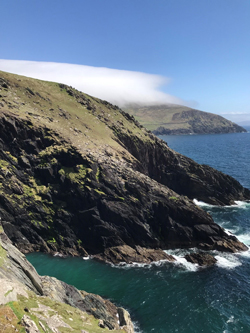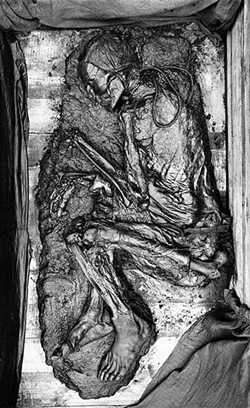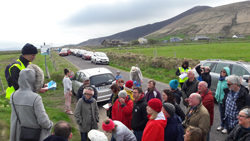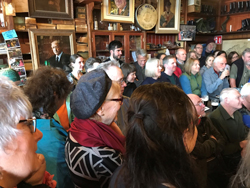Mike Stephenson muses on geology and poetry in Ireland
Stephenson, M., The Art of seeing.
Geoscientist 28 (11), 10-13, 2018
https://doi.org/10.1144/geosci2018-028; Download the pdf here
Over the last year I took part in two unusual events, in Dublin at the National Museum of Ireland, and at the Feile Na Bealtaine arts and poetry festival in Dingle, Ireland. At each, I gave a talk alongside poet and physicist Iggy McGovern, on the poetry of Ted Hughes and Seamus Heaney. We read some wonderful poems and discussed with audiences those great poets’ intuitive grasp of geology and science. An unexpected insight was an appreciation of the similarity of the scientist’s and poet’s inspiration and motivation.

Left, The Dingle peninsular—a great backdrop for poetry and geology.
The talks were an attempt to bring poetry and science together, and came with exhibits, too. At the National Museum of Ireland, the audience was given a private view of fossilised bog bodies that inspired some of Heaney’s most famous poems, while at Dingle the audience was treated to geological walks in the spectacular geology of the Dingle peninsular.
Hughes and Heaney had different styles, but both were inspired by the natural world and geology. To illustrate my point, I include here two poems—Bog Queen, by Heaney, taken from the collection North (1975) and How water began to play, by Hughes, from Crow (1970).
Bog bodies
Heaney was inspired by fossil humans from Irish and European bogs. Bog Queen describes the body of a woman preserved in a bog in Northern Ireland, and dating from about 490 BC. For a palaeontologist or archaeologist interested in preservation, Heaney’s descriptions seem to catch the peculiar nature of the bodies in a way that a scientific description can’t.
Bog Queen
I lay waiting
between turf-face and demesne wall,
between heathery levels
and glass-toothed stone.
My body was braille
for the creeping influences:
dawn suns groped over my head
and cooled at my feet,
through my fabrics and skins
the seeps of winter
digested me,
the illiterate roots
pondered and died
in the cavings
of stomach and socket.
I lay waiting
on the gravel bottom,
my brain darkening,
a jar of spawn
fermenting underground
dreams of Baltic amber.
Bruised berries under my nails,
the vital hoard reducing
in the crock of the pelvis.
My diadem grew carious,
gemstones dropped
in the peat floe
like the bearings of history.
My sash was a black glacier
wrinkling, dyed weaves
and phoenician stitchwork
retted on my breasts'
soft moraines.
I knew winter cold
like the nuzzle of fjords
at my thighs–
the soaked fledge, the heavy
swaddle of hides.
My skull hibernated
in the wet nest of my hair.
Which they robbed.
I was barbered
and stripped
by a turfcutter's spade
who veiled me again
and packed coomb softly
between the stone jambs
at my head and my feet.
Till a peer's wife bribed him.
The plait of my hair
a slimy birth-cord
of bog, had been cut
and I rose from the dark,
hacked bone, skull-ware,
frayed stitches, tufts,
small gleams on the bank.
 Left, The Tollund Man (Image provided to Wikimedia Commons by Nationalmuseet, CC BY-SA 3.0. Photographer: http://samlinger.natmus.dk/DO/10895;https://commons.wikimedia.org/wiki/File:Tollundmanden_DO-10895_original.jpg)
Left, The Tollund Man (Image provided to Wikimedia Commons by Nationalmuseet, CC BY-SA 3.0. Photographer: http://samlinger.natmus.dk/DO/10895;https://commons.wikimedia.org/wiki/File:Tollundmanden_DO-10895_original.jpg)
This poem is a brilliant evocation of the physical appearance of the body, but also of palaeontological preservation and the passing of time. The ‘creeping influences’ evoke chemical fluids and processes that preserved the woman’s body. The lines ‘through my fabrics and skins/ the seeps of winter/ digested me’ evoke fluids tanning the soft tissues.
Physical changes are also pictured: ‘My brain darkening/ a jar of spawn’ conjures organic decay. We see what these strange human artefacts look like. The ‘plait of my hair/ a slimy birth-cord of bog’ is almost a photographic image—but also adds the idea that the woman is symbolically sustained by the bog. The bog’s juices, the ‘seeps of winter’ have given the woman a kind of eternal life.
To me, the vividness of the description supersedes the sort of description that a palaeontologist could provide, bringing an extra dimension of culture and history.
The geologist’s eye
Hughes grew up in West Yorkshire and his early poetry is based in the farms of the Calder valley and the Pennine moorland. I wanted to read
How water began to play because of its geological theme and because it contains something mystical about the physical function of water in the landscape, its fundamental gravitational flow and its role as a carrier of waste.
How water began to play
Water wanted to live
It went to the sun it came weeping back
Water wanted to live
It went to the trees they burned it came weeping back
They rotted it came weeping back
Water wanted to live
It went to the flowers they crumpled it came weeping back
It wanted to live
It went to the womb it met blood
It came weeping back
It went to the womb it met knife
It came weeping back
It went to the womb it met maggot and rottenness
It came weeping back it wanted to die
It went to time it went through the stone door
It came weeping back
It went searching through all space for nothingness
It came weeping back it wanted to die
Till it had no weeping left
It lay at the bottom of all things
Utterly worn out utterly clear
The poem personifies water as a desperate, hapless creature perhaps trying to escape the tasks that it has been set—and perhaps trying to escape Earth itself. Water wants to be set free, but like water vapour in Earth’s atmosphere is held in the planet’s gravitational grip. So water turns itself back to Earth, to the flowers and the trees, where it finds that its role is not just part of the business and nurturing of life, but also of decay, rottenness and death. The cyclical nature of the physical work of water in the landscape takes hold through the rhythm of the poem, of water continually ‘going and coming back’, as it does in the natural world, in the hydrogeology of river catchments.
Then the use of water in the human world appears: ‘It went to the womb it met blood’. Perhaps this is water as a washing medium, carrying waste away. Water goes into and out of people, factories and hospitals, and is finally released in rivers and streams. At the end of the poem, water has gone through such cycles, but is revealed as pure and clear, perhaps as it was before the cycles began. It ‘…lay at the bottom of all things’—revealed as the liquid within which most of life’s business takes place.
Similarities?
 Right, The author, Mike Stephenson, reading Heaney and Hughes poems after a guided geological walk at Clogher Strand, organised by iCRAG volunteers. Feile Na Bealtaine Arts Festival, May 2018.
Right, The author, Mike Stephenson, reading Heaney and Hughes poems after a guided geological walk at Clogher Strand, organised by iCRAG volunteers. Feile Na Bealtaine Arts Festival, May 2018.
Both poems had a powerful effect on the audience. There is something exhilarating about reading a poem in front of an audience—seeing people hanging on every word as it flows from the page. Sometimes it feels that we scientists don’t have the grasp of words that poets have, or at least don’t take as much care with our words as we should.
I wonder, are there similarities in the way that poets and scientists think? Poets take familiar sights, sounds, experiences and look at them in a new way, for example by building on a metaphor. In
Bog Queen, Heaney connects the buried woman by ‘a slimy birth-cord’ to the bog, suggesting that in some way the bog sustains her. In How water began to play, water is desperate and burdened by the gravity that moves it and the human beings that enslave it—a metaphor that gives resonance to the idea that humankind is enslaving the Earth.
 Left, The ‘Morning poetry’ readings at Dick Mack’s pub, Feile Na Bealtaine, May 2018.
Left, The ‘Morning poetry’ readings at Dick Mack’s pub, Feile Na Bealtaine, May 2018.
The poetry events in Ireland taught me that scientific and poetic imagination are similar: They help us see familiar things in a new way. But perhaps science and poetry then diverge by building on those insights differently. The scientist plugs her insight into a theory to revitalise it. The poet builds a story with metaphor and imagery to entertain a reader. As the Italian physicist Carlo Rovelli said: ‘
Our culture is foolish to keep science and poetry separated: they are two tools to open our eyes to the complexity and beauty of the world’.
Permissions:
Bog Queen from
North, by Seamus Heaney and
How water began to play from
Crow, by Ted Hughes reproduced following kind permission from publishers Faber & Faber Ltd, licence numbers: P180618/157 and P180618/156, respectively.
Acknowledgements:
The author would like to thank Ruth Fanning, Iggy McGovern and particularly Fergus McAuliffe, of the Irish Centre for Research in Applied Geosciences (iCRAG), for his organisational skills. Thanks also to other members of the iCRAG team, particularly Anthea Lacchia. The talks were sponsored by iCRAG, Poetry Ireland and Feile Na Bealtaine. Thanks to the National Museum of Ireland, Dublin, for the kind arrangement to view the bog bodies.
Professor Michael Stephenson is Director of Science and Technology at the British Geological Survey, Keyworth; e-mail:
[email protected]
Further reading
Rovelli quote taken from Reality Is Not What It Seems:
The Journey to Quantum Gravity, by Carlo Rovelli.
A recording of the Dingle event:
https://soundcloud.com/user-78861479/tools-to-open-our-eyes-recording
Upcoming conference (23/3/19) “Yorkshire geology, landscapes and literature”:
http://www.yorksgeolsoc.org.uk/EDITABLE/CallForPapersHull2019.pdf
Poetry and Geology: A Celebration (Geological Society of London):
https://www.geolsoc.org.uk/geopoetry
Glob, P.V. (1969) The Bog People: Iron-Age Man Preserved (translated by R. Bruce-Mitford). London: Faber & Faber, 1969. 198 pp.